Photography frames the way we see the world day to day. It documents history, provides insight, inspiration, and drives emotion. A single photo can show triumph, defeat, rebirth, jubilation; and to each viewer the feelings they evoke remain unique.
Below the Military Health System shares a few of the photographs that have captured the imagination and made a difference to those of us supporting those of you.
What's New
">
-
 A series of Broselow pediatric emergency kits, weight-based resuscitation medical kits for children, lie atop a stretcher during pediatric malady training. Shock Trauma Platoon, Combat Logistics Battalion 31, 31st Marine Expeditionary Unit conducted the training during PHIBLEX 33 to prepare its Sailors to treat child patients. (U.S. Marine Corps photo by Sgt. Tiffany Edwards)
Related Photos
A series of Broselow pediatric emergency kits, weight-based resuscitation medical kits for children, lie atop a stretcher during pediatric malady training. Shock Trauma Platoon, Combat Logistics Battalion 31, 31st Marine Expeditionary Unit conducted the training during PHIBLEX 33 to prepare its Sailors to treat child patients. (U.S. Marine Corps photo by Sgt. Tiffany Edwards)
Related Photos
Recommended Content:
Navy Shock Trauma Platoon rehearses pediatric care, procedures
-
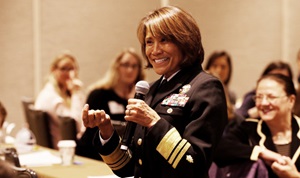 Navy Vice Adm. Raquel Bono, director of the Defense Health Agency, talks to the Association of Women Surgeons meeting in Washington, D.C.
Related Photos
Navy Vice Adm. Raquel Bono, director of the Defense Health Agency, talks to the Association of Women Surgeons meeting in Washington, D.C.
Related Photos
Recommended Content:
Bono to women surgeons: Leadership means helping everyone live up to their potential
-
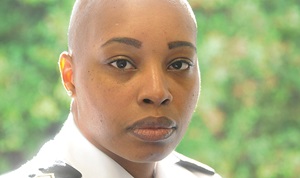 Army Staff Sgt. Tierra Brown, a 392nd Army Band vocalist, was seen by millions singing the National Anthem during the CNN Town Hall with President Barack Obama at Fort Lee, Virginia, Sept. 28. Brown, a Soldier of 14 years, has battled post-traumatic stress disorder for years. (U.S. Army photo by T. Anthony Bell)
Related Photos
Army Staff Sgt. Tierra Brown, a 392nd Army Band vocalist, was seen by millions singing the National Anthem during the CNN Town Hall with President Barack Obama at Fort Lee, Virginia, Sept. 28. Brown, a Soldier of 14 years, has battled post-traumatic stress disorder for years. (U.S. Army photo by T. Anthony Bell)
Related Photos
Recommended Content:
Fight Song: Army singer belts out beautiful tune despite PTSD
-
 Navy Medicine treats and prevents women’s health issues around the world, including ships at sea, using innovative technology and research. The fleet ensures that its ships are equipped to support basic women’s health needs. While the depth of resources depends on the size and mission of each ship, all are equipped with emergency and routine birth control options, basic testing for sexually transmitted infections, equipment for well-woman exams and sick call examinations, and most importantly a professionally trained medical provider. (U.S. Navy photo)
Related Photos
Navy Medicine treats and prevents women’s health issues around the world, including ships at sea, using innovative technology and research. The fleet ensures that its ships are equipped to support basic women’s health needs. While the depth of resources depends on the size and mission of each ship, all are equipped with emergency and routine birth control options, basic testing for sexually transmitted infections, equipment for well-woman exams and sick call examinations, and most importantly a professionally trained medical provider. (U.S. Navy photo)
Related Photos
Recommended Content:
Navy Medicine is prepared to care for women at sea
-
 Navy Vice Adm. Raquel Bono, director of the Defense Health Agency, said military members have to be ready to go anywhere in the world on short notice. To help solve the complexity of care with that readiness aspect, Bono pointed to the Military Health System’s new electronic health record, MHS GENESIS, as key to helping conversations between doctors and patients, no matter where people are. (Courtesy photo)
Related Photos
Navy Vice Adm. Raquel Bono, director of the Defense Health Agency, said military members have to be ready to go anywhere in the world on short notice. To help solve the complexity of care with that readiness aspect, Bono pointed to the Military Health System’s new electronic health record, MHS GENESIS, as key to helping conversations between doctors and patients, no matter where people are. (Courtesy photo)
Related Photos
Recommended Content:
Bono to AFCEA: New electronic health record is key for future of engaging military health patients
-
 Cybersecurity Awareness Month
Related Photos
Cybersecurity Awareness Month
Related Photos
Recommended Content:
Military health cybersecurity officials warn of possible pitfalls of easy access to information
-
 Navy corpsmen treat a notional casualty during a training evolution on Camp Lejeune, North Carolina. The Navy Medical Augmentation Program Sustainment Training brings corpsmen from up and down the east coast to Camp Lejeune to get hands-on training. The corpsmen are all attached to the 2nd Medical Battalion but are assigned at different stations throughout the east coast. (U.S. Marine Corps photo by Lance Cpl. Jon Sosner)
Related Photos
Navy corpsmen treat a notional casualty during a training evolution on Camp Lejeune, North Carolina. The Navy Medical Augmentation Program Sustainment Training brings corpsmen from up and down the east coast to Camp Lejeune to get hands-on training. The corpsmen are all attached to the 2nd Medical Battalion but are assigned at different stations throughout the east coast. (U.S. Marine Corps photo by Lance Cpl. Jon Sosner)
Related Photos
Recommended Content:
Organized chaos: Corpsmen conduct hands-on training
-
 Early detection of the breast cancer can provide early treatment for the service member or their beneficiaries. For those women diagnosed with localized (Stage 1) breast cancer there is a more than 98 percent probability that they will survive five or more years. (U.S. Air Force photo by L.A. Shively)
Related Photos
Early detection of the breast cancer can provide early treatment for the service member or their beneficiaries. For those women diagnosed with localized (Stage 1) breast cancer there is a more than 98 percent probability that they will survive five or more years. (U.S. Air Force photo by L.A. Shively)
Related Photos
Recommended Content:
Army Medicine fights cancer with advanced treatments
-
 Navy Hospital Corpsman 2nd Class Carly Marcum, administers an influenza vaccination to a Sailor aboard USS John C. Stennis. This flu season, the DoD’s entire supply of flu vaccine will be injectable. (U.S. Navy photo by Mass Communication Specialist Seaman Cole C. Pielop)
Related Photos
Navy Hospital Corpsman 2nd Class Carly Marcum, administers an influenza vaccination to a Sailor aboard USS John C. Stennis. This flu season, the DoD’s entire supply of flu vaccine will be injectable. (U.S. Navy photo by Mass Communication Specialist Seaman Cole C. Pielop)
Related Photos
Recommended Content:
DoD will conduct flu immunization program without FluMist
-
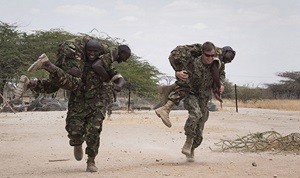 U.S. Navy Petty Officer 3rd Class Nick Mettler, an explosive ordnance disposal technician, races a Kenyan Defense Force combat engineer during a buddy carry lesson for the tactical combat medical training portion of Deliberate Kindle. The medical training was one portion of the course taught by Task Force Sparta, which is currently assigned to Combined Joint Task Force-Horn of Africa. (U.S. Air Force photo by Staff Sgt. Tiffany DeNault)
Related Photos
U.S. Navy Petty Officer 3rd Class Nick Mettler, an explosive ordnance disposal technician, races a Kenyan Defense Force combat engineer during a buddy carry lesson for the tactical combat medical training portion of Deliberate Kindle. The medical training was one portion of the course taught by Task Force Sparta, which is currently assigned to Combined Joint Task Force-Horn of Africa. (U.S. Air Force photo by Staff Sgt. Tiffany DeNault)
Related Photos
Recommended Content:
U.S. Sailors hold medical training with Kenyan Defense Forces
-
 San Antonio Military Medical Center Emergency Department staff treat a patient on Joint Base San Antonio-Fort Sam Houston, Texas. The emergency department serves 20 counties in the Texas region and treats roughly 200 patients a day. (U.S. Air Force photo by Staff Sgt. Kevin Iinuma)
Related Photos
San Antonio Military Medical Center Emergency Department staff treat a patient on Joint Base San Antonio-Fort Sam Houston, Texas. The emergency department serves 20 counties in the Texas region and treats roughly 200 patients a day. (U.S. Air Force photo by Staff Sgt. Kevin Iinuma)
Related Photos
Recommended Content:
Air Force, Army team save lives at the DoD’s only Level 1 trauma center
-
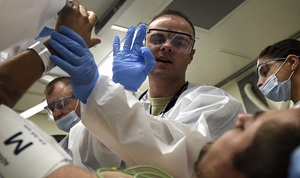 Air Force Capt. (Dr.) Kjell Ballard, emergency room resident, asks a patient to make the OK sign to check mobility of the fingers at the San Antonio Military Medical Center on Joint Base San Antonio-Fort Sam Houston, Texas. Serving 20 counties in the Texas region, the SAMMC Emergency Department treats roughly 200 patients a day. (U.S. Air Force photo by Staff Sgt. Kevin Iinuma)
Related Photos
Air Force Capt. (Dr.) Kjell Ballard, emergency room resident, asks a patient to make the OK sign to check mobility of the fingers at the San Antonio Military Medical Center on Joint Base San Antonio-Fort Sam Houston, Texas. Serving 20 counties in the Texas region, the SAMMC Emergency Department treats roughly 200 patients a day. (U.S. Air Force photo by Staff Sgt. Kevin Iinuma)
Related Photos
Recommended Content:
Air Force, Army team save lives at the DoD’s only Level 1 trauma center
-
 Women with a U.S. Marine Female Engagement Team operating in Europe demonstrated their capabilities in Marine Corps martial arts, non-lethal weapons, foreign weapons handling and combat lifesaving to Romanian and U.S. forces. Women comprise more than 16 percent of U.S. Navy, and 6 percent of Marine Corps personnel respectively, making women’s health essential to force readiness. (U.S. Marine Corps photo by Sgt. Michelle Reif)
Related Photos
Women with a U.S. Marine Female Engagement Team operating in Europe demonstrated their capabilities in Marine Corps martial arts, non-lethal weapons, foreign weapons handling and combat lifesaving to Romanian and U.S. forces. Women comprise more than 16 percent of U.S. Navy, and 6 percent of Marine Corps personnel respectively, making women’s health essential to force readiness. (U.S. Marine Corps photo by Sgt. Michelle Reif)
Related Photos
Recommended Content:
Women’s health essential to force readiness
-
 A sailor returning from a seven-month deployment reunites with his family. (U.S. Navy photo by Mass Communication Specialist 3rd Class Andre T. Richard)
Related Photos
A sailor returning from a seven-month deployment reunites with his family. (U.S. Navy photo by Mass Communication Specialist 3rd Class Andre T. Richard)
Related Photos
Recommended Content:
Deployments can be 'significant' stressor for families but help is available
-
 About 80 million people are infected with HPV right now in the United States. Vaccines are currently available for both males and females to help prevent the virus, which can be linked to various cancers, such as cervical cancer. (U.S. Air Force photo by Staff Sgt. Benjamin W. Stratton)
Related Photos
About 80 million people are infected with HPV right now in the United States. Vaccines are currently available for both males and females to help prevent the virus, which can be linked to various cancers, such as cervical cancer. (U.S. Air Force photo by Staff Sgt. Benjamin W. Stratton)
Related Photos
Recommended Content:
What the experts want you to know about the HPV vaccine
-
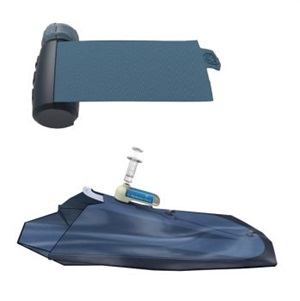 Shown are two of the potential designs being considered for the Acute Care Cover for the Severely Injured Limb, or ACCSIL, a breakthrough medical wrap that will not only cover injured limbs, but also mitigate damage and protect tissue for up to three days. (Photo courtesy of Battelle)
Related Photos
Shown are two of the potential designs being considered for the Acute Care Cover for the Severely Injured Limb, or ACCSIL, a breakthrough medical wrap that will not only cover injured limbs, but also mitigate damage and protect tissue for up to three days. (Photo courtesy of Battelle)
Related Photos
Recommended Content:
Office of Naval Research developing new ways to protect injured limbs
-
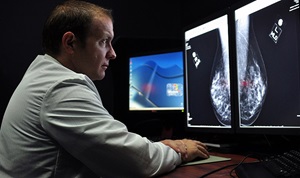 Navy Lt. Cmdr. Erik Ramey, reviews a patient’s x-ray as part of a routine screening mammogram. A mammogram can often detect breast cancer long before it can be felt and usually years before physical symptoms appear. If detected early, breast cancer treatment can be less invasive and more successful. (DoD photo illustration)
Related Photos
Navy Lt. Cmdr. Erik Ramey, reviews a patient’s x-ray as part of a routine screening mammogram. A mammogram can often detect breast cancer long before it can be felt and usually years before physical symptoms appear. If detected early, breast cancer treatment can be less invasive and more successful. (DoD photo illustration)
Related Photos
Recommended Content:
Raise your awareness of breast cancer
-
 Getting regular exercise correlates to better cognitive and physical function in older adults.
Related Photos
Getting regular exercise correlates to better cognitive and physical function in older adults.
Related Photos
Recommended Content:
Healthy aging possible for all: Tips to follow
-
 A Soldier does as many pushups as possible during The Black Knight Challenge at Bagram Air Field, Afghanistan. Excess post-exercise oxygen consumption, also known as “afterburn,” occurs after strenuous exercise as a way to bring your body back to its normal metabolic rate. It takes time for your body to replenish the oxygen used up during exercise, and during this time you continue to burn calories as a result of your elevated metabolism. (U.S. Army photo by Staff Sgt. Michael K. Selvage)
Related Photos
A Soldier does as many pushups as possible during The Black Knight Challenge at Bagram Air Field, Afghanistan. Excess post-exercise oxygen consumption, also known as “afterburn,” occurs after strenuous exercise as a way to bring your body back to its normal metabolic rate. It takes time for your body to replenish the oxygen used up during exercise, and during this time you continue to burn calories as a result of your elevated metabolism. (U.S. Army photo by Staff Sgt. Michael K. Selvage)
Related Photos
Recommended Content:
EPOC-alypse, now
-
 Mourning the loss of a loved one to suicide can be a difficult and painful experience. There is help and support available for service members and their families who are going through this experience. (U.S. Marine Corps photo by Cpl. Russel Midori)
Related Photos
Mourning the loss of a loved one to suicide can be a difficult and painful experience. There is help and support available for service members and their families who are going through this experience. (U.S. Marine Corps photo by Cpl. Russel Midori)
Related Photos
Recommended Content:
Mourning the loss of a loved one from suicide